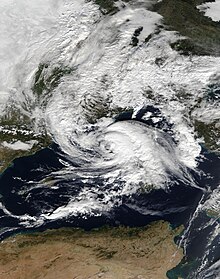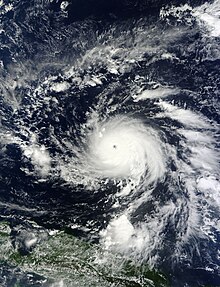Portal:Tropical cyclones
The Tropical Cyclones Portal

A tropical cyclone is a storm system characterized by a large low-pressure center, a closed low-level circulation and a spiral arrangement of numerous thunderstorms that produce strong winds and heavy rainfall. Tropical cyclones feed on the heat released when moist air rises, resulting in condensation of water vapor contained in the moist air. They are fueled by a different heat mechanism than other cyclonic windstorms such as Nor'easters, European windstorms and polar lows, leading to their classification as "warm core" storm systems. Most tropical cyclones originate in the doldrums, approximately ten degrees from the Equator.
The term "tropical" refers to both the geographic origin of these systems, which form almost exclusively in tropical regions of the globe, as well as to their formation in maritime tropical air masses. The term "cyclone" refers to such storms' cyclonic nature, with anticlockwise rotation in the Northern Hemisphere and clockwise rotation in the Southern Hemisphere. Depending on its location and intensity, a tropical cyclone may be referred to by names such as "hurricane", "typhoon", "tropical storm", "cyclonic storm", "tropical depression" or simply "cyclone".
Types of cyclone: 1. A "Typhoon" is a tropical cyclone located in the North-west Pacific Ocean which has the most cyclonic activity and storms occur year-round. 2. A "Hurricane" is also a tropical cyclone located at the North Atlantic Ocean or North-east Pacific Ocean which have an average storm activity and storms typically form between May 15 and November 30. 3. A "Cyclone" is a tropical cyclone that occurs in the South Pacific and Indian Oceans.
Selected named cyclone -
Tropical Storm Rolf, also known as Tropical Storm 01M, was an unusual Mediterranean tropical storm that brought flooding to Italy, France, Spain, and Switzerland in November 2011. Rolf originated from an extratropical system near western France on 4 November. Despite the generally unfavorable conditions in the Mediterranean Sea, Rolf transitioned into a subtropical depression on 7 November, before becoming a tropical storm later that day. On 8 November, Rolf reached its peak intensity, with 1-minute sustained winds peaking at 85 km/h (53 mph) and a minimum central pressure of 991 mb (29.3 inHg). During the next day, the storm made landfall on the island of Île du Levant, in France, and soon afterward, near Hyères in southeastern France. Following its second landfall, Rolf quickly weakened and dissipated on 10 November. Rolf was the first tropical cyclone ever to be officially monitored by the NOAA in the Mediterranean Sea.
Rolf caused widespread flooding across southwestern Europe, especially in France and Italy, with the majority of the damage from the storm occurring in those two countries. The rainfall worsened a series of ongoing floods in Europe at the time. Torrential rainfall from Rolf caused multiple rivers to overflow their banks in France and Italy, flooding multiple cities and resulting in extensive property damage. The storm forced numerous schools and businesses to close temporarily, and also caused significant damage to 300 farms in France. Floodwaters from Rolf's rainfall also cut the power to over 8,000 customers and necessitated thousands of rescues, in addition to forcing thousands of evacuations. Rolf killed 12 people, and was at the time, the costliest Mediterranean tropical-like cyclone on record, causing at least $1.25 billion (2011 USD, €926 million) in damages. It was later surpassed by Storm Daniel in 2023. (Full article...)Selected article -
The effects of Typhoon Bopha in the Caroline Islands were significant, though limited in extent in comparison to the cyclone's intensity. Typhoon Bopha originated from a tropical depression south of Pohnpei on November 25, 2012, and tracked generally westward for more than a week. During this time, it threatened several islands across Micronesia, prompting the issuance of typhoon watches and warnings. The system skirted the Nomoi Islands on November 28 where it caused limited damage. Thereafter, it became a threat to Palau as an intense typhoon. Residents there boarded up their homes and some evacuated to public shelters while officials enacted a strict curfew during the typhoon's passage. Bopha passed 55 km (34 mi) south of Angaur island, or 100 km (62 mi) south of Babeldaob, on December 2 with winds of 185 km/h (115 mph).
Damage was most severe in the states of Angaur, Melekeok, Ngiwal, and Ngaraard where storm surge damaged or destroyed many homes. Electricity and water service in many areas was lost during the storm, and remained so for over a week in the hardest hit areas. Throughout Palau, 92 homes were destroyed while 59 others sustained severe damage. Total damage amounted to US$10.1 million with repair costs estimated at US$15–20 million. A state of emergency was declared on December 5 while the Palau Red Cross Society assisted with recovery efforts. Palau's congress allocated US$10 million for relief while international donors provided a collective US$235,000 in aid. (Full article...)Selected image -

Selected season -

The 2017 Pacific hurricane season was an above average Pacific hurricane season in terms of named storms, though less active than the previous three, featuring eighteen named storms, nine hurricanes, and four major hurricanes. Despite the considerable amount of activity, most of the storms were weak and short-lived. The season officially started on May 15 in the eastern Pacific Ocean, and on June 1 in the central Pacific; they both ended on November 30. These dates conventionally delimit the period of each year when most tropical cyclones form in the respective regions. However, the formation of tropical cyclones is possible at any time of the year, as illustrated in 2017 by the formation of the season's first named storm, Tropical Storm Adrian, on May 9. At the time, this was the earliest formation of a tropical storm on record in the eastern Pacific basin proper (east of 140°W). The season saw near-average activity in terms of accumulated cyclone energy (ACE), in stark contrast to the extremely active seasons in 2014, 2015, and 2016; and for the first time since 2012, no tropical cyclones formed in the Central Pacific basin. However, for the third year in a row, the season featured above-average activity in July, with the ACE value being the fifth highest for the month. Damage across the basin reached $375.28 million (2017 USD), while 45 people were killed by the various storms.
Prior to the start of this season, the National Hurricane Center (NHC) changed its policy to permit issuance of advisories on disturbances that were not yet tropical cyclones but had a high chance to become one, and were expected to bring tropical storm or hurricane conditions to landmasses within 48 hours. As a result of this change, watches and warnings could be issued by local authorities. Such systems would be termed as "Potential Tropical Cyclones". The first system to receive this designation was Potential Tropical Cyclone Fourteen-E, which developed into Tropical Storm Lidia south-southeast of the Baja California Peninsula on August 30.
(Full article...)Related portals
Currently active tropical cyclones

Italicized basins are unofficial.
- North Atlantic (2024)
- No active systems
- East and Central Pacific (2024)
- No active systems
- West Pacific (2024)
- No active systems
- North Indian Ocean (2024)
- No active systems
- Mediterranean (2023–24)
- No active systems
- South-West Indian Ocean (2023–24)
- No active systems
- Australian region (2023–24)
- No active systems
- South Pacific (2023–24)
- No active systems
- South Atlantic (2023–24)
- No active systems
Last updated: 21:50, 2 June 2024 (UTC)
Tropical cyclone anniversaries

June 13,
- 1977 - The 1977 Oman cyclone makes landfall over in eastern Oman killing 105 people in total.
- 2006 - Tropical Storm Alberto made landfall on the Florida Panhandle as a strong tropical storm. Alberto brought heavy rain to the southeastern United States, causing about $500,000 in damage.
- 2015 - Hurricane Carlos (pictured) reaches its peak strength off the coast of Southwestern Mexico, causing about $1 million in damages.

June 14,
- 1904 - The first storm of the 1904 Atlantic hurricane season made landfall in eastern Cuba, killing at least 87 people.
- 1991 - Typhoon Yunya (pictured) reaches Category 3 typhoon intensity prior to making landfall in Luzon in the Philippines the same day as Mount Pinatubo made its largest eruption. The rainfall from the typhoon mixed with the volcanic ash, causing severe lahars.

June 15,
- 2014 - Tropical Storm Hagibis (pictured) makes landfall over in southern China killing 11 people with damages totaled up to CN¥815 million (US$131 million).
Did you know…




- …that the Joint Typhoon Warning Center considers that Typhoon Vera (pictured) of 1986 is actually two distinct systems, formed from two separated low-level circulations?
- …that Hurricane Agatha (pictured) was the strongest Pacific hurricane to make landfall in Mexico in May since records began in 1949?
- …that Cyclone Raquel (track pictured) travelled between the Australian and South Pacific basins between the 2014–15 and 2015–16 seasons, spanning both seasons in both basins?
- …that Cyclone Amphan (pictured) in 2020 was the first storm to be classified as a Super Cyclonic Storm in the Bay of Bengal since 1999?
General images -

Tropical cyclones move into the contiguous United States from the Atlantic Ocean, the Gulf of Mexico, and the eastern Pacific Ocean. The highest rainfall totals in the country have been measured across the Gulf Coast and lower portions of the Eastern Seaboard. Intermediate amounts have been measured across the Southwest, New England, and the Midwest. The northern Great Plains and Pacific Northwest have received the lowest amounts, as those regions lie exceptionally far from the breeding grounds of Atlantic and Eastern Pacific tropical cyclones.
The wettest tropical cyclone in the United States storm on record is Hurricane Harvey, which dumped 60.58 in (1,539 mm) of rain on Southeast Texas in 2017. Tropical Storm Claudette holds the national 24-hour rainfall record: 42.00 in (1,067 mm) in Alvin, Texas. (Full article...)Topics
Subcategories
Related WikiProjects
WikiProject Tropical cyclones is the central point of coordination for Wikipedia's coverage of tropical cyclones. Feel free to help!
WikiProject Weather is the main center point of coordination for Wikipedia's coverage of meteorology in general, and the parent project of WikiProject Tropical cyclones. Three other branches of WikiProject Weather in particular share significant overlaps with WikiProject Tropical cyclones:
- The Non-tropical storms task force coordinates most of Wikipedia's coverage on extratropical cyclones, which tropical cyclones often transition into near the end of their lifespan.
- The Floods task force takes on the scope of flooding events all over the world, with rainfall from tropical cyclones a significant factor in many of them.
- WikiProject Severe weather documents the effects of extreme weather such as tornadoes, which landfalling tropical cyclones can produce.
Things you can do
 |
Here are some tasks awaiting attention:
|
Wikimedia
The following Wikimedia Foundation sister projects provide more on this subject:
-
Commons
Free media repository -
Wikibooks
Free textbooks and manuals -
Wikidata
Free knowledge base -
Wikinews
Free-content news -
Wikiquote
Collection of quotations -
Wikisource
Free-content library -
Wikiversity
Free learning tools -
Wikivoyage
Free travel guide -
Wiktionary
Dictionary and thesaurus
























































